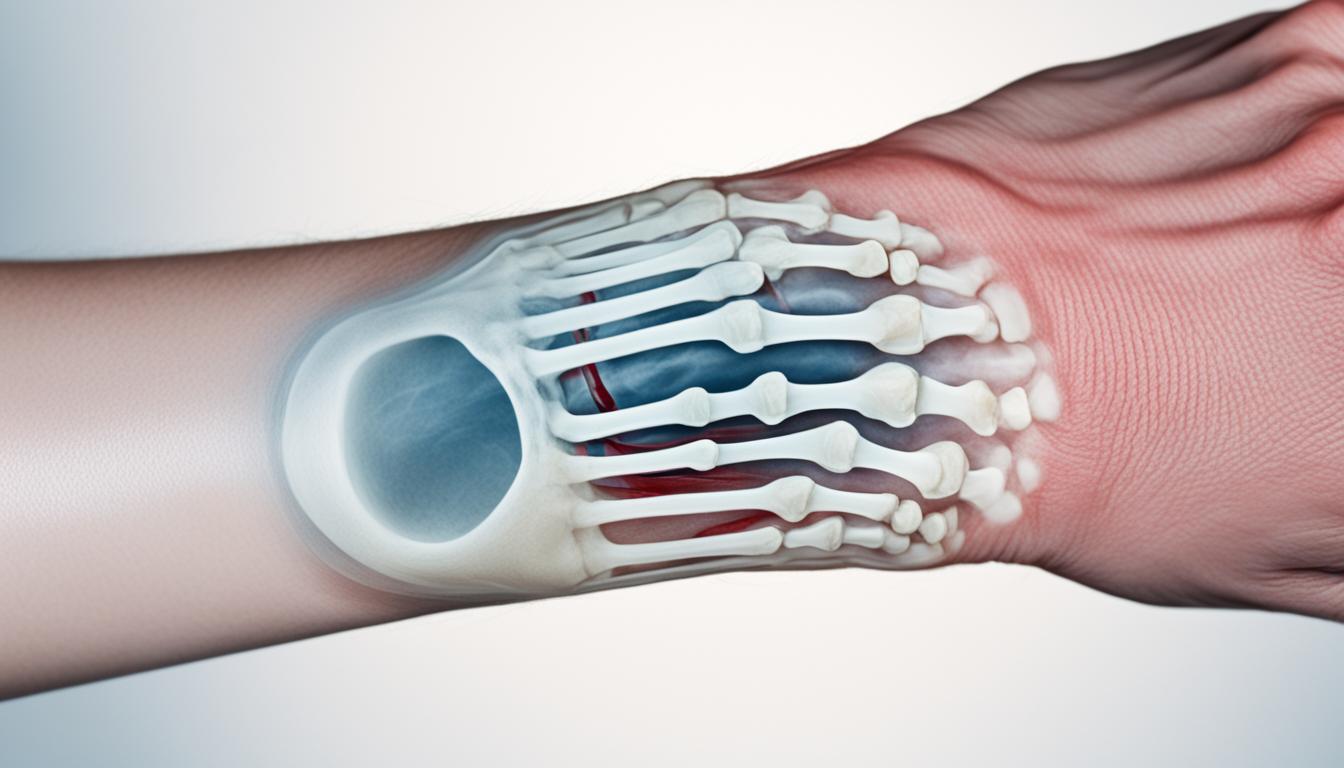Wrist fractures happen a lot and can really hurt. They are often from a hard hit to the wrist, like in a fall or while playing sports. The wrist has many small bones and ligaments. These can break and cause pain, swelling, and even a change in shape of the wrist. Doctors use X-rays to see if the wrist is broken. Usually, they treat it by making sure the wrist doesn’t move too much with a cast or splint. Some might need surgery. But, new treatments like stem cell therapy can also help heal wrist fractures.
Key Takeaways:
- Wrist fractures are common and can cause significant pain and disability.
- Symptoms of a wrist fracture include pain, swelling, and deformity of the wrist.
- Diagnosis is typically done through medical imaging, such as X-rays.
- Traditional treatment options for wrist fractures include immobilization with a cast or splint, physical therapy, and in some cases, surgery.
- Stem cell therapy is an innovative regenerative treatment option for wrist fractures.
Common Causes and Symptoms of Wrist Fractures
Wrist fractures often happen because of sudden blows, falls, and sports accidents. It’s key to know what causes these fractures and what symptoms to look out for. This awareness helps get the right treatment on time.
Causes of Wrist Fractures
Wrist fractures are usually due to:
- Falling and trying to stop it with a hand.
- Getting hurt in sports, like a hard hit or strong force on the wrist.
- Car crashes.
- High-impact trauma or fights.
Symptoms of Wrist Fractures
Knowing the signs of a wrist fracture is important for quick medical care. You might notice:
- Sharp pain, especially when you move your wrist or press on it.
- Swollen and tender wrist.
- Wrist looks different or not aligned right.
Some fractures won’t visibly change your wrist’s shape but are very painful. If you think you have a fracture from these signs, seeing a doctor is a must for a proper check-up.
Diagnosis of Wrist Fractures
Doctors use X-rays or CT scans to spot wrist fractures. These tests show if there are broken or shifted bones in your wrist. They help understand how bad the injury is and its location.
Knowing about wrist fractures early and accurately helps doctors pick the best treatments. This way, you can recover well and face fewer issues.
| Causes | Symptoms |
|---|---|
| – Accidental falls – Sports-related injuries – Motor vehicle accidents – Physical altercations |
– Intense pain – Swelling – Deformity |
Traditional Treatment Options for Wrist Fractures
When treating wrist fractures, doctors have several traditional ways to help healing. These methods stabilize broken bones, sometimes realigning them. They also help the wrist regain its strength and movement.
Immobilization with a Wrist Cast
A wrist cast is often used for wrist fractures. It keeps the bones in place so they can heal. This method offers support and protects the wrist.
Doctors make wrist casts from fiberglass or plaster. Because they’re custom-made, they fit the person perfectly. Depending on how bad the fracture is, a cast might be needed for weeks or months.
Wrist Surgery
For serious fractures or if bones are not aligned, surgery may be needed. This surgery fixes the bones, ligaments, or tendons. The goal is to make the wrist function like it should.
Surgeons use screws, plates, or wires to hold bones in place during surgery. Sometimes, bone grafts are necessary. The way surgery is done depends on the fracture and the person’s needs.
Physical Therapy
Physical therapy is vital for healing wrist fractures. It aims to make the wrist strong, flexible, and mobile again. Therapists use different exercises to reduce pain and improve the wrist’s function.
Therapy gradually increases in difficulty to rebuild wrist strength. It includes stretches, strengthening, and special exercises. All these are tailored to an individual’s recovery needs.
Immobility with a cast, surgery if needed, and physical therapy are known effective ways to heal wrist fractures. But the right approach depends on how severe the injury is. It also includes health and lifestyle details of the person.
Innovative Stem Cell Therapy for Wrist Fractures
Stem cell therapy is a new way to treat wrist fractures by using the patient’s own stem cells. It helps the wrist heal and makes new tissue. This gives hope to people with wrist fractures and helps reduce their pain.
Doctors now use special cells like mesenchymal stem cells, Micro-Fragmented Adipose Tissue (MFAT), Bone Marrow Aspirate Concentrate (BMAC), and Platelet Rich Plasma (PRP). These not only lessen pain and swelling but also help grow new bone and tissue. This speeds up healing and makes the wrist work better.
Compared to old methods, stem cell therapy is less invasive. It is a good choice for people who want to get better without a lot of surgery. This method uses the body’s own power to heal. It aims to bring back free movement and make life better for those with wrist fractures.

